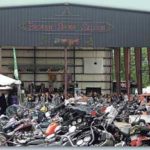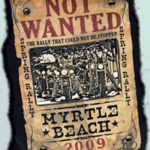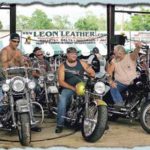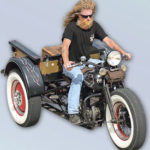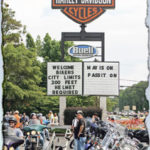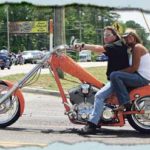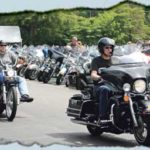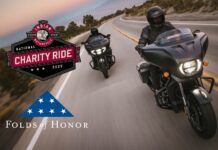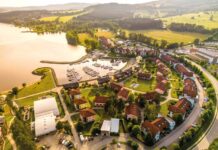A rally divided
Riders declare, “We came anyway”
Myrtle Beach, S.C., May 8–17—Once I hit the Louisiana border, I pulled over into the official Visitor’s Welcome Center, next to the lake and near a sign warning “NO SWIMMING” with an outline of an alligator underneath the alert. I grabbed a meatloaf sandwich and a lukewarm beer from my road grip and began to untangle my helmet from beneath its webbing net. Between Myrtle Beach and me were more than 800 miles of states with mandated helmet laws. South Carolina remains one of the lone holdouts along the eastern seaboard (between Florida and the far northern states) that does not have a “universal” helmet law. That is, except for one tiny hamlet that’s the center of much controversy, sour attitudes and blatant contempt—the City of Myrtle Beach proper.
After last year’s Spring Rally (#68), a shooting during Atlantic Beach Bike Week the following weekend left a local college student dead. The Myrtle Beach City Council pounced on the opportunity and, coming to the aid of the beleaguered citizenry they claimed had grown “weary of three weeks of noise and traffic congestion each May,” promptly canceled the 2009 Cruisin’ the Coast Myrtle Beach Spring Rally. This action came despite the fact that the killers were homegrown creeps with no connection to the rally. But the City Council dug their heels in and, since it’s damn hard to “unpounce,” ramped it up several notches, instituting a property tax increase to provide monies to aid in ending the rallies, enacting a city-wide universal helmet law (for the rider’s safety only, of course) along with mandatory protective eyewear use while riding and a strict noise ordinance. Other new legislation included limited parking, restricted storage of trailers, outlawing open containers and eliminating alcohol consumption and parties in any parking lot, garage or landscaped area within the city limits. (And some of the best parties during Cruisin’ the Coast have always been those held in the driveways and parking lots along the Grand Strand of Ocean Boulevard while watching the riders profile back and forth.)
Public reaction was swift, with local businesses and vendors crying foul and threatening lawsuits. Myrtle Beach Mayor John Rhodes just shrugged it off and, with a City Council eager to follow his every lead (no matter the possible unconstitutionality), launched a website justifying their position and boldly declaring the spring rally canceled and dead. Shortly afterward, the Carolina Harley-Davidson Dealers Association (the major players promoting the rally for years) decided you can’t fight City Hall (City Council in this case) and, in a surprising move, redirected their efforts to the more hospitable surroundings of New Bern, North Carolina, birthing the “Spring Rally of New Bern.” So it was with great interest that I tossed the remains of my sandwich to the gators, killed my beer and strapped the DOT-approved helmet to my noggin to check out the fate of the 69th Annual Myrtle Beach Bike Week.
The next two days in the saddle were hard won, almost all of it in the rain. In Atlanta, the storm was so fierce I lost most of the day holed up under an overpass. But then about 10 miles outside of the Grand Strand, the clouds parted and the sun came out. It was the first rays I’d seen in days and I hoped it was a good sign. Fifteen miles earlier (and well before the town of Conway) was the first indicator of Myrtle Beach’s bitter decision to block this year’s rally—electronic signage blinking the message, “Expect Delays, Helmet & Eye Protection Required, MBPD CHECKPOINTS.” So it seemed they were quite serious about the matter and holding true on their threat.
Rolling into Myrtle on Highway 501, the town’s main access artery, the scene was the same as in years past, with riders jamming the lanes and loaded with gear and passengers. But something was different—a tension in the air—an edge to the riders that exuded an attitude that they knew this was a war zone. It seemed everyone knew this was a battle, an us-against-them struggle for the right to maintain our lifestyle. Many lidless riders had half-helmets secured to their handlebar risers and within easy access in case they suddenly came upon an unexpected Myrtle Beach City Limits sign. And that pattern would be common for the entire week—on alert and watchful for the unexpected annoyance of the Myrtle Gestapo.
As in years past, I was bunked down in Garden City Beach, south of the dreaded MB city limits. The first sign of the locals’ attitude about this year’s rally was when I went out to stock up on supplies for the rest of the week. That’s when the frail, gray-haired 70-something grocery sacker at the corner store patted my hand as she said, “We love you guys. Don’t pay any attention to those old fuddy-duddies up in Myrtle Beach. We’re glad you’re here.” And with South Carolina having the third-highest unemployment figures in the nation (at 8.4 percent, South Carolina ties with California), I’m sure she meant every word.
May is on—pass it on
After laying in my cache of grub and beverage of choice, I promptly went out and broke the law; unintentionally of course, while cruising up Business 17 to Myrtle Beach Harley-Davidson without a helmet. I knew that the shop—a favorite gathering site during the rally—was actually outside the city limits despite its name. But coming up from the south, all the entrances to the dealership were blocked, forcing riders to continue another 100 yards, make a U-turn and enter from the north. No big deal until out of the corner of my eye I noticed the MB city limits sign as I rode into the wasteland. Oh crap! But surprisingly, there were no cops waiting by the roadside or lurking in the underbrush. After making the U-turn and pulling into the shop’s parking lot, for the first time in all my years of attending this event I was actually able to find a spot, and quite easily, I might add. (Normally I’ve had to weave through the congested parking lot only to be redirected to the adjacent parking “pasture” that is located behind the Iron Gate facility next door.) I grabbed the first attendant with a vest and flag and questioned him about the situation. He told me the County had come down before the event and informed the City of Myrtle Beach that it was just too damn dangerous to have traffic pulling into the Harley shop from the south and that they could not begin their enforcement until after the first available U-turn. The City backed down and granted the County their demands, allowing a 200-yard encroachment into their domain. Later I checked out the parking availability behind Iron Gate and discovered only six bikes where normally the place is slammed—an event repeated over and over all weekend, with no waiting and plenty of parking on hand. And while neither MB H-D nor the Iron Gate was dead, both were definitely in need of a respirator, with vendor attendance slashed dramatically from last year.
The next morning I left to explore the Myrtle Beach Ghost Town. Once again cruising up Bus. 17 (this time with a DOT-approved helmet firmly affixed to noggin), I entered the forbidden zone and passed by a huge electronic sign that I guess was supposed to alert riders that they were crossing into MB city limits. But it wasn’t illuminated. In fact, during my entire stay I never saw an illuminated sign giving proper notice to attendees that they were entering a mandatory helmet-use area. When I came to the intersection of Farrow Boulevard (to the West) and Ocean Boulevard (to the East), I was compelled to ride along the Grand Strand to witness the damage for myself. Ocean Boulevard is Myrtle Beach Ground Zero and was pretty much deserted. Every hotel had “Vacancy” listed on its marquee. And while one hotel sign stated “Welcome All Snowbirds” and another said “Welcome Friends,” at least 75 percent of these suffering accommodations held firm and had “WELCOME BIKERS” in bold print on their signage. And the deals you could have been privy to this week were sweet. Ocean-view rooms were going for a mere $40, with side-view rooms only costing $30 (barely enough to have the maid clean up after your stay). Last year these same rooms were easily charging $200 a day and were fully booked, turning away late arrivals without reservations. The Dog House South is located within the city limits and when I rode by on the last Saturday of the rally at noon, only two bikes were in the parking lot, and both were Hondas. Over at the Rat Hole, this 15 acres of grassy fields and viewing bleachers (and the scene of many a rowdy field event series of barrel push and slow race contests) continued to pull in a sizable crowd due to the fact that the site is just outside the city limits. But even their numbers seemed to be down slightly. Pulling out onto Socastee Boulevard after leaving the Rat Hole, if you made a right and rode 100 yards, you would be in the clutches of Myrtle Beach, with no warning of your imminent doom upon your intrusion into the “Rally is Dead” zone.
The first two motorcycle-related fatalities occurred on Friday night. Both happened on Highway 544 and within 30 minutes of each other. Fault for each accident was attributed to inattentive automobile drivers.
A new destination for this year’s rally was the MB Speedway on Highway 501 right down the road from last year’s ill-fated Hard Rock Park, a mega complex of asphalt and concrete that the rally fully embraced only to see it succumb to bankruptcy after six months. Although the Speedway has been around for many years, this was the first time it was open during Bike Week, and it featured a handful of vendors and a stunt riding team. Teak Collins is the son of the owners and is also the owner/operator of the Lighthouse Motel on the Ocean Boulevard strip. Attendance at the Speedway was light throughout the week and in Teak’s words, “Guess we picked one hell of a year to start a new venue.” He added that he had spoken earlier with Mayor Rhodes and told him, “We don’t want to replace you. Or City Council. But we do want this fixed.” He promised he would do his best to make sure that the Speedway would be a permanent addition to Bike Week in the future.
Your papers, please—your papers!
Before I left the Speedway on Saturday, Teak warned me of the checkpoint set up right down 501 at the US 17 Bypass on the way into Myrtle. They had erected a roadblock as traffic came over the bridge spanning the Intracoastal Waterway on Friday between 11:00 a.m. and 1:00 p.m. Two lanes of bridge traffic expands into three lanes at the bottom of the bridge, but about 25 officers conducted a total shutdown and funneled all vehicles into one lane, stopping both cars and bikes to check driver licenses, registrations and “safety equipment violations” (helmets). Curious to survey the impact, I headed straight into the fray but found no roadblock or checkpoint. Later I discovered that Saturday’s traffic check was held between one and three in the afternoon—just to keep everyone off balance, I guess. Area residents were also caught up in the melee as a steady stream of vehicles inched over the causeway, many just trying to get home but instead waiting in line for an hour or more. Local resident Megan Marczewski was quoted in the town’s paper, The Sun News, stating, “I have no idea what’s going on. I’m not exactly thrilled about it.” Notch up another brilliant move by MB City Council.
A small group of vendors was set up at Barefoot Landing, but by far, the largest congregation of vendors and people had to be those at MB Mall. But even that location was far from full. HB Spokes, in the far north district, saw a substantial crowd on Saturday but I was told that Friday was huge even by last year’s standards. And that was understandable, since I witnessed a large trailer parade pulling out early Saturday morning and heading home. Others I talked with were leaving early to try and catch the tail end of the New Bern experience to see if it had any potential.
The new regulations and the “no welcome” attitude of the City of Myrtle Beach effectively divided this year’s Myrtle Beach Bike Week, which was their intent. But although the City may have cut the Rally in half, they did not cut off its head. And while their scheme of “divide and conquer” may have scored large this year, there’s another adage that goes, “A house divided will not stand.” And this story is very divided with many businesses and local shop owners yet to weigh in. Plus there’s a supply of strong soldiers planning new strategies to confront this wound in our side. One is Charlie Campbell, the owner of the Dead Dog Saloon in Murrells Inlet, who has proposed completely rebranding the rally, eliminating any reference to Myrtle Beach. Possibilities include renaming the event the Grand Strand Rally or the Murrells Inlet Rally, but nothing has been finalized. And neither of those new tags might pass muster for venues located on the north end. And despite an ongoing attempt to drive a stake through the heart of this event, it’s a pretty big monster that will take more than one egotistical, old fuddy-duddy City Council to destroy. Time, lost revenue and public opinion will be the deciding factors in the rally’s eventual future.
I left Myrtle Beach on Sunday under clear skies. Twenty miles down the road, the roof caved in and I rode more than 450 miles through a blinding rainstorm. But the ride home wasn’t nearly as harrowing as the one over. I survived the onslaught, the nerve-racking road conditions and the pounding abuse of a severe environment gone haywire. We can only hope Myrtle Beach Bike Week fares so well.


